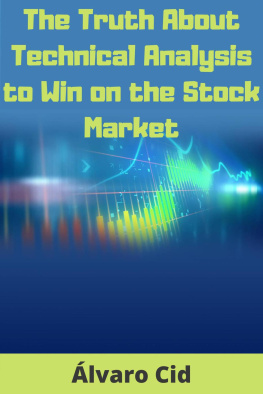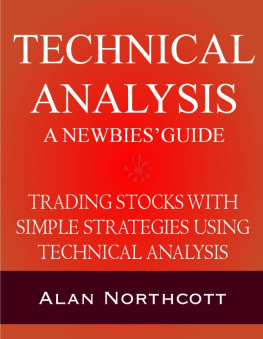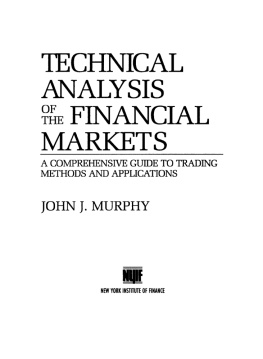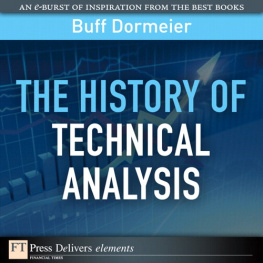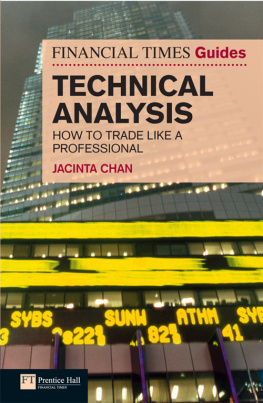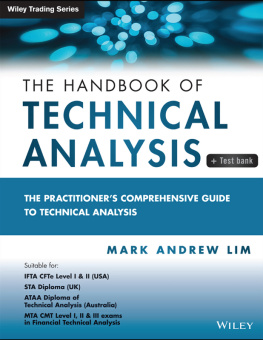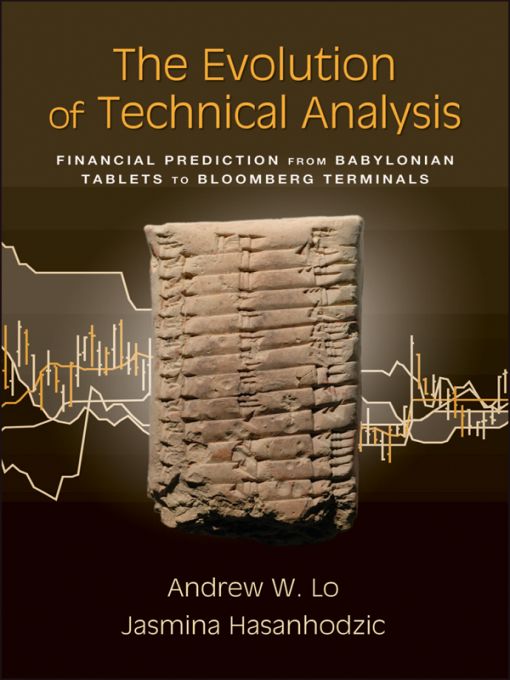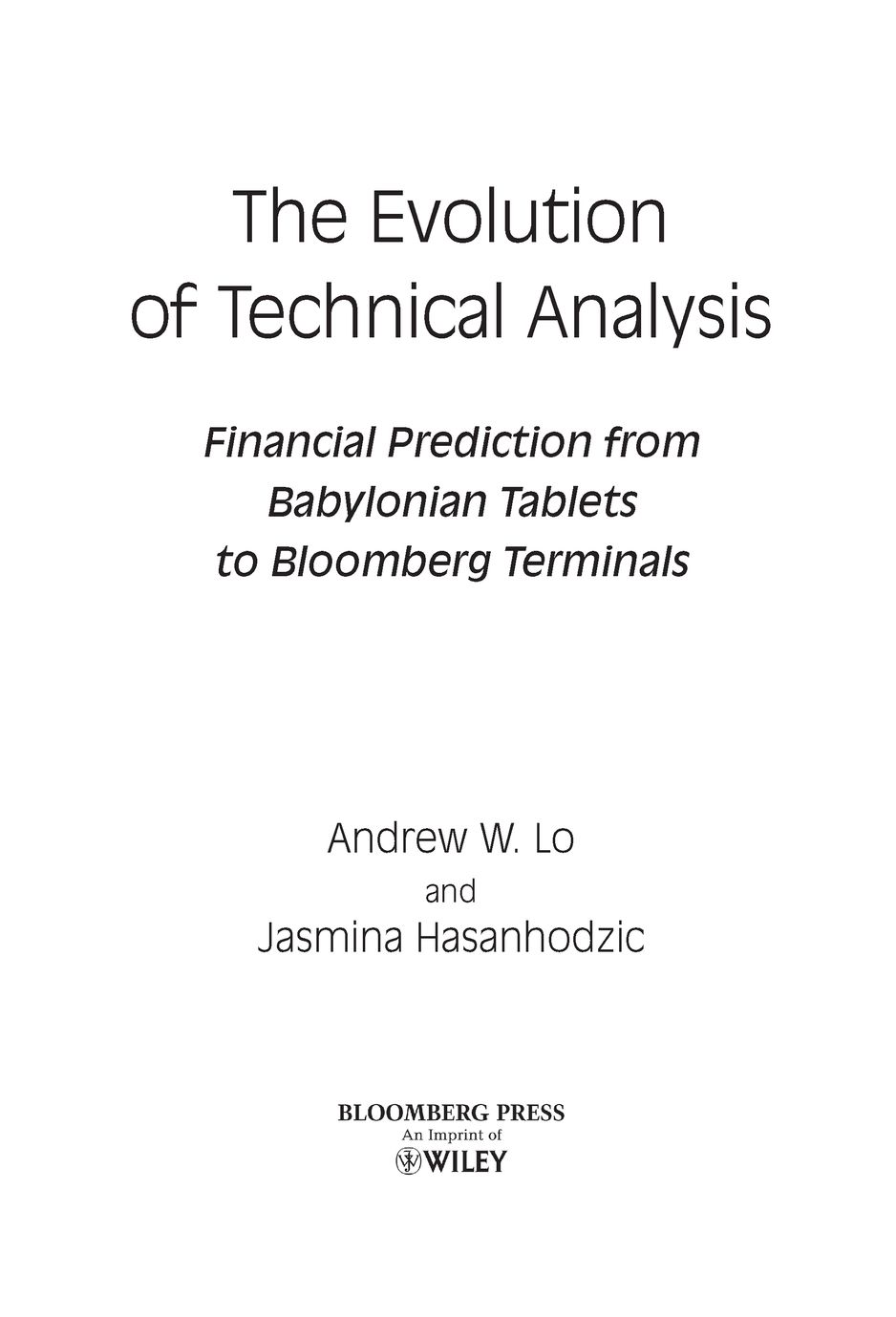Table of Contents
To our mothers
Introduction
Technical analysisthe forecasting of prices based on patterns in past market datais something of a black sheep in modern economics. Some skeptics view it as kissing cousins with sleazy speculation or gambling, while others regard it as a relic that is only slightly more sophisticated than the reading of chicken entrails. Proponents of quantitative analysis, who take physics as the ideal model of how economic science ought to look, view technical analysis as antiquated and contrived in its very foundations. They demand mathematical proofs of its validity and dismiss as exception bias the strong betting averages and impressive bottom lines of successful technicians. We make it no secret, then, that we regard technical analysis as a legitimate and useful discipline, tarred by spurious associations and deserving of further academic study.
Some of this skepticism is understandable in light of the historical origins (and occasional abuses) of technical analysis. Many of its methods come down to us from the days before computers and the number-crunching-intensive theories they made possible, and not all of its methods have been thoroughly explored within the quantitative frameworks now available. Many terms and concepts in technical analysis can seem abstruse or outmoded; it is easy to see how a discipline that involves eyeballing charts for patterns with names like head and shoulders and cup with a handle might seem at first blush more akin to astrology than science. However, many of these are merely heuristics developed in the precomputer age when calculating a simple statistic was a formidable task. For instance, the 10-day moving average became a fixture of technical analysis not because it was optimal, but because it was trivially easy to compute. Indeed, there are many such concepts in classical technical analysis that could benefit from quantitative reformulation.
Ultimately, however, both technical and quantitative analysis serve similar purposes: They both attempt to predict the future based on models of the past. One is statistical, the other is intuitive. Whereas a quant minimizes a sum of squared residuals to find the best-fitting line given the data, a technician estimates it by looking at the charts, searching for tell-tale patterns, and inferring the thoughts and feelings of other market players. Both approaches have merit. This is not to say that they are equal; clearly, quantitative methods have won hands down, dominating the investment industry because of their demonstrable value-added. But technical analysis is surprisingly resilient and persistent, and in some corners of the financial industrysuch as the trading of commodities and currenciesit is still the dominant mode of analysis. This state of affairs suggests that technical analysis may have something to contribute, even to the most sophisticated quant. Fortunately, a slow but sure reconciliation is underway.
Though big strides have been made throughout history and in recent years toward developing a more systematic approach to technical analysis, technicians remain ostracized to this day. For evidence, look no further than the Financial Industry Regulatory Author itys official recognition of the Chartered Market Technician designation, which occurred only in 2005. Part of the reason is that technical analysis is often associated with the speculators, bear raiders, and market cornerers of previous eras. As Tony Tabell, a veteran technical analyst and an heir to the technical brokerage business founded by his father Edmund Tabell in the 1930s, explains:
Its hard to visualize unless youve talked to people who were involved how difficult this was in the atmosphere of [the] 1930s and 1940s. The entire brokerage business was a basket case. Volume on the NYSE was under a million shares. This was the 1930s, the Great Depression, nobody had any money, and if they did, they were very leery about investing. Furthermore, technical analysis had been associated with the excesses of the 1920s. All of the various Securities Acts were designed to get rid of the manipulative market operations that had characterized the 20s. Since technical work to a great degree (certainly point and figure charts) had been originally conceived as a means of detecting pool operations, confessing that you were involved in technical work at that point was sort of equivalent to confessing that you were some kind of a low-level criminal. I saw some [of ] this, because the remainder of this attitude was still kicking around when I started in the business in the 1950s, but I can imagine how incredible it must have been in the 30s and 40s.
The efficient markets hypothesis (EMH), formulated in the writings of Samuelson (1965) and Fama (1965a,b; 1970), did not help much. According to this theory, there are no patterns in market data that are exploitable through trading strategies. Ever since the advent of modern financea theory based on rational expectations and market efficiencytechnical analysis has been dismissed in academic circles as a mathematical impossibility. As Princeton University economist Burton Malkiel concluded in his influential book A Random Walk Down Wall Street (1973), under scientific scrutiny, chart-reading must share a pedestal with alchemy.
As we recount the premature obituaries for technical analysis, it is worth noting as an aside that recent research has not only documented departures from the EMHin the form of cognitive biases such as overconfidence, overreaction, loss aversion, and herdingbut has also included new theoretical underpinnings for technical analysis and the empirical validation of certain technical patterns and indicators.
Malkiels lumping of technical analysis with alchemy is not entirely coincidental, for here we come across another historical reason for the fields questionable reputationtechnical analysis was used in conjunction with astrology since the earliest times. The ancient Babylonians would methodically record, often intraday, the prices of various commodities, but they would also assign those same commodities to the astrological regions of Pisces and Taurus, depending on whether they were bullish or bearish. Similarly, in addition to the very logical lists of weights, measures, and exchange rates recorded in medieval merchant manuals, they also often contained lengthy astrological appendixes and advised their readers to buy, sell, or begin anything when they were in the region of Virgo. Yet another example is provided by Christopher Kurz, a sixteenth-century Antwerp trader, who claimed to be able to forecast prices of commodities up to 20 days in advance using his technical trading system based on back-tested astrological signals.
Such close links between technical analysis and astrology are naturally a cause for suspicion and skepticism today. But for our ancestors, astrology was a way of life, applied to wide-ranging areas of human endeavor including warfare and medicine. It was no coincidence that Christopher Kurz doubled as a political astrologerhe is known for having forecasted the extinction of the papacy, among other thingswhile Thales of Miletus, one of the Seven Sages of ancient Greece, made meteorological predictions based on movements of the stars and planets. That societies would base their operations in part on astrology sounds absurd today, but interestingly, if we view astrology as a random number generator of the precomputer age, its prevalence becomes more understandable. Then, as now, forecastingfinancial and otherwisewas a business of probabilities. Just as computer-generated random numbers are part of todays statistical forecasting modelsfor example, the commonly used Markov Chain Monte Carlo method for constructing Bayesian forecastsastrology may be thought of as a random input in ancient forecasting models.



